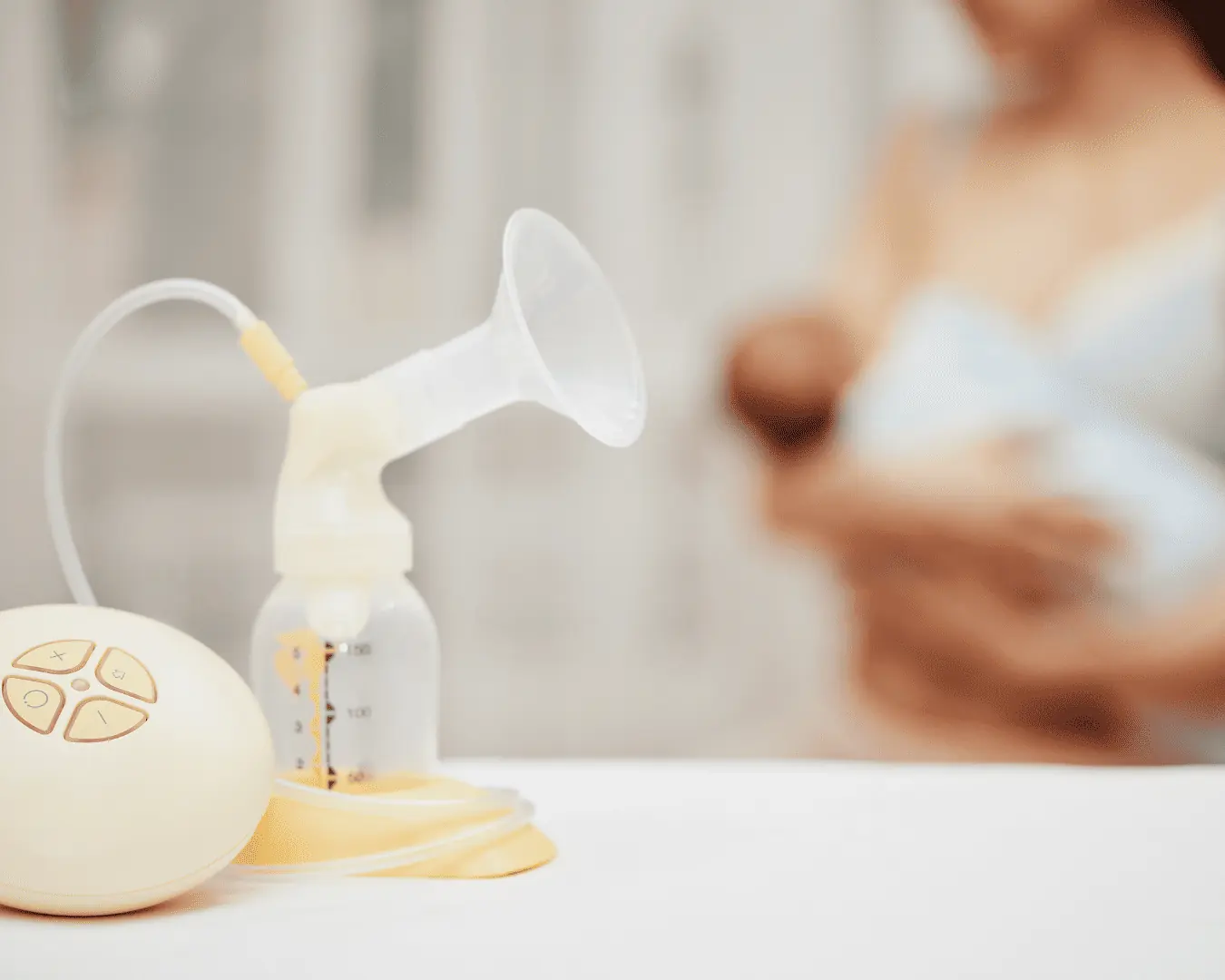How to Combine Breastfeeding and Pumping
This post may contain affiliate links. As an Amazon Associate, I earn from qualifying purchases.
Breastfeeding is a fantastic way for a mom to bond with her baby. But sometimes, being the only person responsible for feeding your baby adds to the exhaustion of being a new mom. This is where learning how to combine breastfeeding and pumping breast milk becomes necessary. It also allows other caregivers to bond with your baby.
Exclusively breastfeeding means that your infant requires you to be nearby every time. Feeding your baby breast milk in a bottle can help relieve some of this stress.
Whatever your reasons for combining both methods to nurse your child, below are a few tips to help you have a smooth experience.
My personal experience with breastfeeding and pumping
I always knew I wanted to exclusively breastfeed before I started having children. Little did I know it was going to be a lot of work.
When I had my first child, I assumed breastfeeding him would come naturally to me. Boy, was I in for a surprise! Breastfeeding was painful and left me with sore nipples because we both needed to learn how to latch and breastfeed correctly.
But I was determined to feed my baby with only breast milk!
Whenever my baby cried when he was hungry, I also cried because of the pain I experienced while breastfeeding.
Thankfully I bought a breast pump while shopping for my baby. So I pumped exclusively for 3 months because that was how long it took my sore nipples to heal and for my baby to latch correctly.
Not long after, the discomfort of breastfeeding became a thing of the past, and I was able to combine breastfeeding and pumping.
Need breastfeeding help? TIPS ABOUT BREASTFEEDING: A FULL GUIDE
Reasons why any mom may need to combine breastfeeding and pumping
There are many reasons why mothers may need to combine the two methods when nursing their babies. They include:
- Your baby is not latching correctly and is not breastfeeding well.
- To help boost and maintain your milk supply, especially when you cannot breastfeed your baby because of some medication you are taking.
- To relieve sore breasts and engorgement (although too much of this will perpetuate it).
- Prolonged separation from your baby. For example, if she is a preemie in the neonatal intensive care unit (NICU).
- Allowing other family members to bond with the baby.
- Bottle feeding provides a way for a second caregiver to bond with the baby.
- Building a milk stash/storage for when your maternity leave comes to an end.
Related Read: Colostrum Harvesting: Why Some Moms Are Trying It
How to effectively combine breastfeeding & pumping
Your breasts will produce more milk as long as your baby demands it. So, pumping between breastfeeding sessions can increase your milk supply. Here are some reminders for getting started:
- If you are pumping or planning to pump because of work, you should still continue to breastfeed your baby when you return home. Because babies usually get more milk when they breastfeed directly versus the amount of milk mothers pump during a typical pumping session.
- While your baby nurses on one side, you can collect extra milk produced from the other breast let-down with a milk collector or Hakka style device.
- Keep your stress in check. It is not just unpleasant; it can make pumping less successful. Stress can reduce your milk supply.
- Also, having a lot of skin-to-skin contact in-between pumping sessions can help to boost the breast milk supply. Every moment you hold and snuggle your baby, hormones (including oxytocin) will surge and help you make more breast milk for your baby.
Tips for how to combine breastfeeding and pumping
Most often, combining the two will involve the sequence of feeding first, them pumping. Let’s review all the top tips:
- Before you start breastfeeding or pumping, make sure you are comfortable. It is hard to make enough milk when you are stressed.
- Massaging your breasts before, during, and after pumping can be soothing and help to increase the amount of milk pumped.
- Invest in a double electric breast pump and a hands-free pumping bra (or these days- a completely hands free version like the WIlow). It makes a huge difference by allowing you to multitask and pump while carrying out your day-to-day activities.
- You should ensure that your breast pump’s flanges are the correct size for your breasts. Ill-fitting ones may lead to a reduced milk supply and make pumping painful.
- Stock up on extra breast pump parts and supplies such as milk storage bags, tubing & flanges, etc. This way, you are prepared if something gets broken or is lost.
- Pumping after breastfeeding is preferable. Once you are ready to start pumping, nurse your baby, then pump afterward. Pumping should follow as closely to your baby’s feeding schedule as possible. This means pumping every 3-4 hours for about 15 minutes each.
- As your milk flow gradually stops, allow the breast pump to run for a few more minutes. This increases the demand for your breasts to produce more milk (if needed).
- Do something you enjoy while pumping, like reading a novel or watching your favorite show. Also, listening to relaxing music or even the sound of your baby can encourage an increased milk supply.
- Keep items that smell like babies, like a onesie or a blanket, while pumping. This can help focus the body to respond to the pump with a strong letdown!
- Make sure you have a solid support system so others can help you dedicate time to pumping milk and breastfeeding as needed.
- One way you might be able to get a little more sleep would be to share the load with your partner or a family member. You take care of breastfeeding or pumping, and your partner can handle cleaning up the supplies.
- Eat regular meals while pumping and stay hydrated. Pumping, like breastfeeding, can make you extra hungry and thirsty. Keep healthy snacks and a water bottle on hand.
- And if you find yourself struggling with breastfeeding, pumping, or combining the two, seek help from your healthcare provider or a lactation consultant for medical advice.
NURSING ON THE GO: THE BEST PACKAGED SNACKS FOR BREASTFEEDING MOMS
How much milk do I need to pump?
Nothing is more frustrating than not being able to pump enough milk for your baby when you have to be away for work or other events. Many new moms question if they are producing enough milk, which can lead to anxiety.
Breastfeeding is a supply-and-demand process. And adopting the correct technique will help you get enough milk with each pumping session.
You do not need a freezer full of breastmilk before you go out. The general rule is that you should pump 1 ounce every 1 hour you will be away from your baby. That is, 8 hours work day + 1-hour average commute = 9 hours, 9 -10 ounces/day will do perfectly!
As your baby gets older and your supply stabilizes, you should be able to go longer between sessions and pump more breast milk each session.
How to pump and store breastmilk
Pumping your breast milk
Pumping milk for your baby is one thing. Safely storing it is another.
You should clean and sterilize your breast pump parts very well before and between each use. Germs love the warm, moist environment that a breast pump provides. Making sure you clean and dry your pump parts well can not be overemphasized and will keep you and your little one safe.
9 BEST NIPPLE SHIELDS FOR BREASTFEEDING
Storing your breast milk
When you have finished pumping your breast milk, you should store it safely before your baby needs it. After pumping, clearly label the breast milk bag with your name, the date, and the time it was expressed. Using a mini fridge is a good option for storage.
Freshly expressed milk can be stored using the guidelines below:
Up to 4 hours at room temperature, 4 days in the refrigerator, and in the freezer for up to 6 months.
Having a breastfeeding and pumping schedule is helpful!
Combining breastfeeding and pumping can feel overwhelming. Finding a schedule that works will take some practice and getting used to.
As much as possible, you should pump your breast milk following a similar schedule as when you breastfeed.
If you plan to pump and breastfeed in the same hour, breastfeed first until your baby’s milk needs are fully satisfied before you begin pumping. There is no specific number of times a day that works for everyone.
Below is a sample pumping schedule for working moms
6:00 AM – Breastfeed
8:00 AM – Breastfeed when the caregiver arrives
10:00 AM – Pump
1:00 PM – Pump
4:00 PM – Breastfeed when the caregiver arrives
6:00 PM – Breastfeed
8:00 PM – Breastfeed at bedtime
10:30 PM – Pump
3:00 AM – Breastfeed
If you have more questions, the best option is to see a lactation consultant!
What are the pros and cons of combining breastfeeding and pumping?
Pros
- It increases the amount of milk your breasts produce
- It allows you and other family members to bond with your little one
- You can sleep better when someone else can feed your baby breast milk in a bottle
- Relieves engorgement pressure and helps prevent clogged ducts
- It encourages your baby to accept bottle feeding so they do not rely solely on breastfeeding, especially when you resume work or need to go out
Cons
- Oversupply issues, like clogged ducts, engorgement, and mastitis- because of the additional pumping
- Milk can go bad if it is not safely handled and stored
- Pumping more will mean plenty of washing and sanitizing for you, like bottles and pump accessories
- Your nipples may become sore if you over-pump
If you have any specific health concerns or if problems develop when you combine breastfeeding and pumping, you should search for a certified lactation consultant for guidance.
In conclusion
Learning how to combine breastfeeding and pumping can be a total game-changer while nursing your child.
Many women fear being away from their babies for extended periods can affect their mental health. You also do not have to switch to exclusively pumping when you return to work. Your baby still needs to enjoy your warmth and cuddles while suckling at your breast.
You can switch back and forth between pumping and breastfeeding with the exact schedule and supplies. Allowing you to enjoy the best of both worlds.
You should not hesitate to speak to your doctor or a certified lactation consultant if you experience breast discomfort or find that your milk supply is at an uncomfortable level.
Their support can help to make your experience of breastfeeding and pumping a more comfortable one. It will take practice and patience, but it is possible to help your baby learn to do both.
Always remember, the most important thing is that you and your child are comfortable with whatever feeding method you choose!
Do you have other helpful tips on how to combine breastfeeding and pumping? I would love to hear them!







